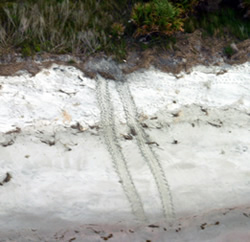Current Nest Count
 The SCDNR began monitoring sea turtle nesting activities and strandings in the late 1970s. Information gained from this program contributes to ongoing
sea turtle nest management and protection projects on all of the state's beaches.There are approximately 300 kilometers of ocean-facing sandy beaches in
South Carolina that provide suitable nesting habitat for sea turtles. To date, loggerheads, green turtles, leatherbacks and rarely Kemp’s ridleys
sea turtle nests have been recorded on South Carolina beaches. By far the most common nesting species is the loggerhead. In South Carolina, nesting surveys
and nest protection measures are carried out by a variety of public agencies such as the SCDNR, USFWS, South Carolina Department of Parks and Recreation
and Coastal Carolina University. Several private organizations and numerous volunteers are also actively involved with sea turtle protection work. Altogether,
more than 1100 individuals participate in nest monitoring activities in South Carolina each year. Results from all South Carolina sea turtle nesting beach
projects are submitted to the SCDNR and compiled for the State and made available to federal agencies. These data are crucial in monitoring populations,
formulating protective regulations, making management decisions, and maximizing reproduction for recovery.
The SCDNR began monitoring sea turtle nesting activities and strandings in the late 1970s. Information gained from this program contributes to ongoing
sea turtle nest management and protection projects on all of the state's beaches.There are approximately 300 kilometers of ocean-facing sandy beaches in
South Carolina that provide suitable nesting habitat for sea turtles. To date, loggerheads, green turtles, leatherbacks and rarely Kemp’s ridleys
sea turtle nests have been recorded on South Carolina beaches. By far the most common nesting species is the loggerhead. In South Carolina, nesting surveys
and nest protection measures are carried out by a variety of public agencies such as the SCDNR, USFWS, South Carolina Department of Parks and Recreation
and Coastal Carolina University. Several private organizations and numerous volunteers are also actively involved with sea turtle protection work. Altogether,
more than 1100 individuals participate in nest monitoring activities in South Carolina each year. Results from all South Carolina sea turtle nesting beach
projects are submitted to the SCDNR and compiled for the State and made available to federal agencies. These data are crucial in monitoring populations,
formulating protective regulations, making management decisions, and maximizing reproduction for recovery.
The DNR Marine Turtle Conservation Program is also participating in a multi-state project along with the Georgia Department of Natural Resources, the North Carolina Wildlife and Resources Commission and the University of Georgia to answer several basic loggerhead sea turtle nesting questions. The answers to these questions will help biologists better understand the status of the loggerhead population. Currently, the actual number of loggerhead sea turtles that nest in South Carolina is not known. We will use DNA genetic fingerprinting (CSI for sea turtles) to identify individual loggerhead nesting females, how many nests they are laying each year, and how long they go in between nesting years. This information will provide a much more accurate census of the actual nesting population. You can follow the progress of this study on our genetics study web page provided by Seaturtle.org: http://www.seaturtle.org/nestdb/genetics.shtml.



